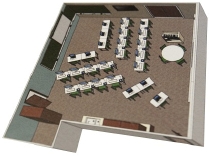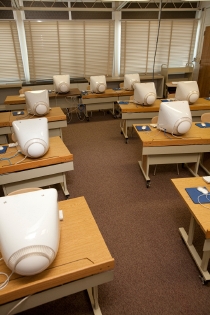OUTREACH
Students' designs help others sit up and take notice
At New Roots Charter School, a new public high school located in the 180-year-old Clinton House in downtown Ithaca, students attend class in what used to be two adjoining hotel rooms. A long wooden bar runs across another. The gymnasium is a few blocks away, and the building lacks lockers, science labs and other amenities of an established school.

Tina Nilsen-Hodges, New Roots principal, associate professor Lorraine Maxwell and Thomas Levine '11. See larger image
To remake the one-time lavish hotel into a community-based school, New Roots leaders are relying on ideas from classes taught by Lorraine Maxwell, associate professor of design and environmental analysis (DEA) in the College of Human Ecology.
At a more traditional educational setting, Caroline Elementary School (also in the Ithaca school district), Maxwell's students have advised library staff in the past year on how to alter the floor plan to prolong the life of the space and lessen interruptions to student use.
In both instances, the Cornell students have focused on economical, research-based interior design strategies to create optimal learning environments that are based on the needs of faculty, students and staff.
"The research is clear that the quality of a school's physical environment is closely linked to academic performance," says Maxwell, an environmental psychologist who's been teaching the course, Programming Methods in Design, since 2004. "If students are distracted by noise or crowding, too hot or too cold, or can't see because the lighting is dim, they're not likely to succeed. Fortunately, many of these issues can be corrected through improved design – in some cases at little or no cost."

A portion of the students' floor plan schematic for the Caroline Elementary School library. See larger image
At New Roots, after learning about the school's most pressing facilities needs and class observations, interviews with staff and student surveys, three graduate students prepared a strategic facilities plan to outline the school's long-term space needs. DEA undergraduate teams followed up with detailed programming documents with advice for overhauling the school's various spaces and suggesting surrounding locations to use for off-site services.
Among their key suggestions are ideas to expand storage space for students, create a student lounge and reassign teacher and administrative staff offices.
"The Cornell classes have really helped us to think through how to use existing spaces creatively to support our program, eliminating the need for costly construction that would have altered an historic structure," says New Roots founder and principal Tina Nilsen-Hodges. "By repurposing the Clinton House, we have saved resources that might otherwise have been expended on building a new structure, while putting public tax dollars to the dual purpose of providing a relatively low-cost school facility while supporting historic preservation. This is truly sustainable thinking at work."

Computer lab in Caroline Elementary School library. See larger image
DEA undergraduates performed a similar analysis for Caroline Elementary School library's circulation area, office rooms and its computer lab. They discovered that children tended to cluster at the story time area near the circulation desk, creating gridlock. In addition, bookcases sometimes blocked staff views of student areas, so children were prone to act up when out of sight.
The school has subsequently, as recommended, developed a plan to improve the ergonomics of its computer lab and reorganize the library to reduce clutter and congestion and invite more student participation.
"They did almost exactly what we suggested," says DEA student Justine Dupal '11, who toured the revamped space in November. "It's been really rewarding to design something that is focused on user needs and is giving kids a better learning experience."
Maxwell says she plans to have her students do a similar project with the library at Ithaca's Fall Creek Elementary School this coming fall.